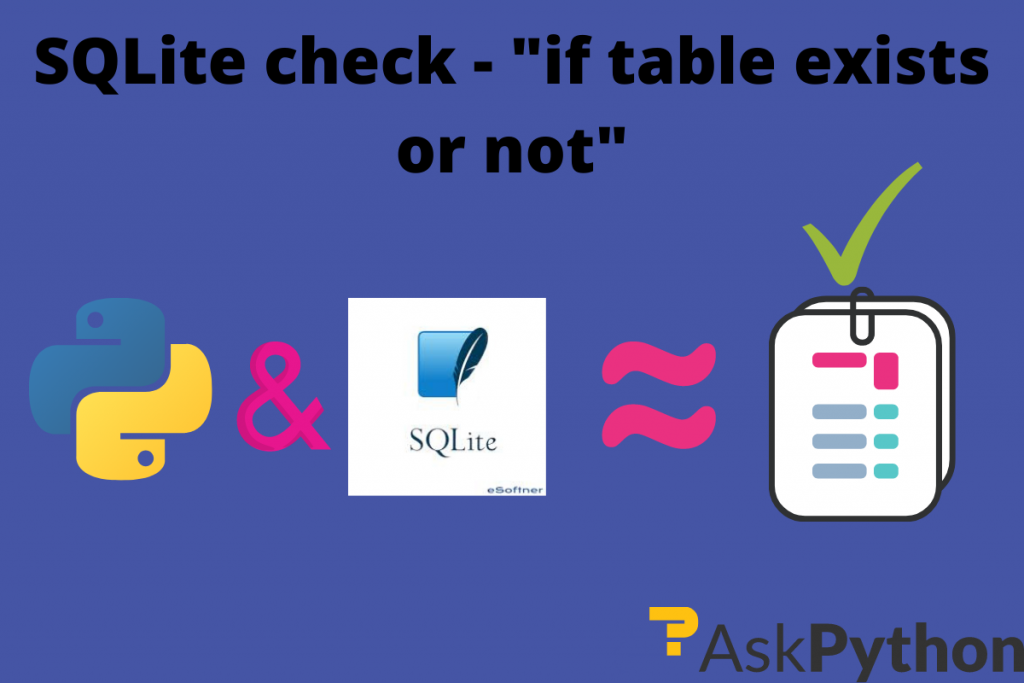Hey readers! In this article we will be studying how we can check if a table exists using SQLite3. This is all gonna easy for us because we will be using Python and its built-in module SQLite3. So, let us go for it.
Please note: You should be familiar with SQLite3 and SQL commands.
Also read: How to insert multiple records in Sqlite3 database
What’s covered in this article?
- Creating a database.
- Adding some data to it.
- Purposely deleting the table.
- Creating a program to check if a table exists in Python
Creating a database using Python SQLite3
In this section we shall create a sample database namely company and add an employee table to it. This table contains the basic info about employees in that company. Make sure you create a new Working Directory that holds all the stuff.
Code:
import sqlite3
connection = sqlite3.connect('databases/company.db') # file path
# create a cursor object from the cursor class
cur = connection.cursor()
cur.execute('''
CREATE TABLE employee(
emp_id integer,
name text,
designation text,
email text
)''')
print("Database created successfully!!!")
# committing our connection
connection.commit()
# close our connection
connection.close()
Output:
Database created successfully!!!
This adds a “company.db” file in the databases folder. This file contains our employee table. It’s an empty table, so let us add some data to it.
Adding Data to a Table using Python SQLite3
Using the “executemany()” function we can insert multiple records at once in our table. So, we will be using the same here:
Code:
import sqlite3
connection = sqlite3.connect('databases/company.db') # file path
cur = connection.cursor()
# creating a list of items
records = [(100, 'Arvind Sharma', 'Software Engineer', '[email protected]'),
(102, 'Neha Thakur', 'Project Manager', '[email protected]'),
(103, 'Pavitra Patil', 'Database Engineer', '[email protected]')]
cur.executemany("INSERT INTO employee VALUES (?,?,?,?)", records)
print('Data added successfully!!!')
connection.commit()
# close our connection
connection.close()
Output:
Data added successfully!!!
So, these are the records we just added through a Python script.
Purposely deleting the table
Now we will purposely delete the table. We use the default SQL’s DROP TABLE command.
Code:
import sqlite3
connection = sqlite3.connect('databases/company.db')
connection.execute("DROP TABLE employee")
print("Your table has been deleted!!!")
connection.close()
Output:
Your table has been deleted!!!
Check if a table exists using Python SQLite3
Now, to check whether the table exists or not. We need to write a code that will try to locate that table and if not found it should return a message like: “Table not found!!”. For this purpose the fetchall() function is useful. This enables us to retrieve/access all the information a table contains in SQL. This returns a list of all the info it gets.
Logic:
- The SELECT * FROM table name command tries to retrieve the whole table from the database.
- If the table exists it will store it in a list called as data_list using the fetchall() function.
- If the data exists it will store it in a list.
- If no table exists then it will throw OperationalError from the sqlite3 module.
- Handle it through except block and then print a message “no such table: table_name”.
Code:
import sqlite3
connection = sqlite3.connect('databases/company.db')
cur = connection.cursor()
try:
cur.execute("SELECT * FROM employee")
# storing the data in a list
data_list = cur.fetchall()
print('NAME' + '\t\tEMAIL')
print('--------' + '\t\t-------------')
for item in items:
print(item[0] + ' | ' + item[1] + '\t' + item[2])
except sqlite3.OperationalError:
print("No such table: employee")
connection.commit()
connection.close()
Output:
No such table: employee
So, in this way we can detect whether a table in a particular table exists in a database or not.
Conclusion
In this way, we conclude this article here. I hope the reader has got some knowledge about how to use databases using SQLite3. This may prove a great helping hand to someone who is new to DBs.
